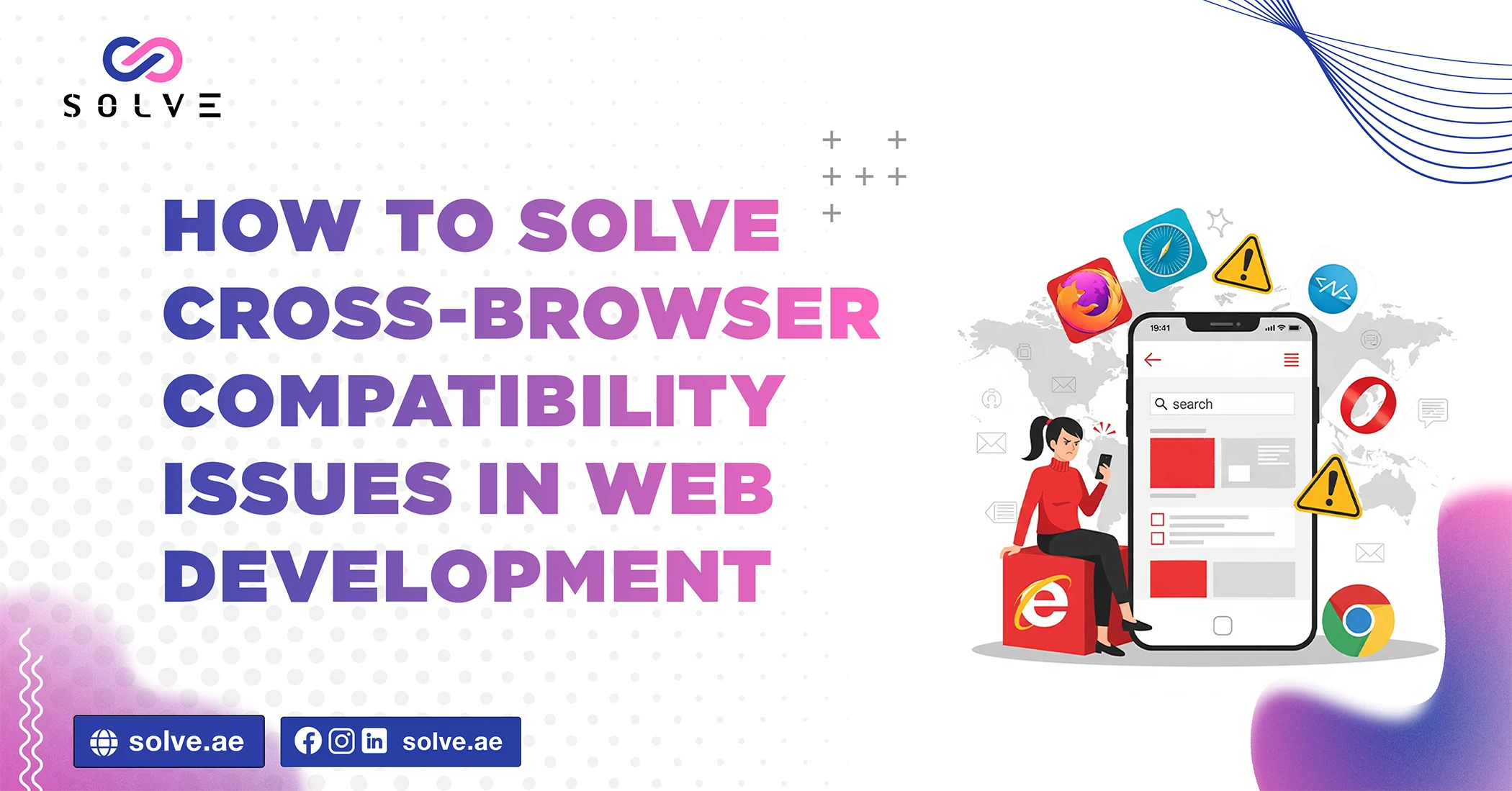- By Vanshika Choudhary
- June 6, 2025
Web development is about making sites that perfectly work for any user, no matter which browser or device they choose to use. But these delectable problems of cross-browser incompatibility can be an obstacle. These are mismatches in the performance of a site in one browser, and in the second one, the site gets displayed improperly or malfunctions. Addressing these problems is important for giving the professionals a consistent user experience.
Common Causes of Cross-Browser Compatibility Issues
Understanding the root cause of cross-browser issues In web development, step one is in solving them. Several factors can lead to less-than-desirable behavior of a website, depending on different browsers.
Different Rendering Engines
Each browser uses a different rendering engine to fetch and display the web pages. For example, Chrome uses Blink; Firefox uses Gecko; and Safari uses WebKit. These engines interpret the HTML, CSS, and JavaScript slightly differently from one another, and thus any slight difference in the interpretation of the CSS properties or JavaScript functions by the rendering engine can result in layout shifts, broken features, or out-of-place styling. Developers need to be aware of such differences and test their sites on multiple browsers to achieve a consistent look and feel for their site.
CSS and HTML Variations
CSS Properties and incompatible implementation of HTML Elements are present in most browsers. As some of them are rejected or simply considered experimental, others are sometimes implemented differently or not at all. For instance, some relatively new CSS properties-likely `grid` or `flexbox`-will work well with the newest browsers but become a nightmare with the older ones. Similarly, non-standard or deprecated HTML tags tend to cause unexpected behavior. So to avoid such nightmares, stick to well-supported and standard-compliant code and provide fallbacks for those features that are not universally accepted.
JavaScript Incompatibilities
JavaScript engines vary greatly from one browser to another, particularly when novel features or new APIs come into play. Running code in the latest JavaScript syntax or using browser-specific APIs could work in some browsers and simply not in others. Some ES6 features or Web APIs are unavailable or require polyfills in older browsers. Ensuring the working of your scripts in several browsers with the help of various tools, along with Babel transpiling modern JavaScript, may prove fruitful for compatibility.
Some of the Best Practices to Follow for Cross-Browser Compatibility
Following best practices during the development phase would keep many compatibility issues at bay and make sure the site works for all.
Use Standard Compliant Code
Cross-browser compatibility begins with writing code that strictly adheres to official web standards. The modern browsers have made huge efforts in supporting these standards, so the more you use them, the fewer issues you are going to have. Avoid using deprecated HTML tags and experimental CSS properties unless they have fallbacks. Find and fix errors early by running your markup through a validator such as the W3C Markup Validation Service. Standards thus increase the likelihood that a site will behave consistently in all browsers
Test Early and Often!
It is important to keep testing your site on different browsers and devices to encounter compatibility issues before they get deeply embedded in a codebase. Conduct numerous browser tests from the beginning of development to the end, and use testing tools and services to make the process easy. Early testing helps in troubleshooting quick fixes, thus saving time and other costs.
Use CSS Resets and Normalize
Each browser gives its own default style to HTML elements, which causes discrepancies. These CSS resets and normalization libraries nullify those discrepancies by providing a common baseline onto which you can build styles. For instance, Normalize.css makes sure elements render more consistently between different browsers, and CSS Reset eliminates all default styling. When starting from a blank slate, it’s simpler to achieve a consistent look and feel.
Tools and Methods for Cross-Browser Testing
Modern tools allow for easy identification and rectification of compatibility problems, making sure that your site is functional everywhere.
Automated Testing Platforms
Automated testing platforms like LambdaTest, BrowserStack, and Sauce Labs have your back in testing your website over hundreds of browser and device combinations, eliminating any need to install them on your own. With screenshots, videos, and interactive sessions, these platforms make it very easy to identify and diagnose the issues. Automated testing saves time and elevates coverage while providing a more reliable website.
Manual Browser Testing
Automation is good, but manual testing is better. Operate a variety of browsers on your site to discover subtle differences in font renderings or animation glitches that automated tools may not catch. Check out our latest blog post on Essential Features Every UAE Business Website Needs in 2025
Responsive Design Testing
People access websites from their phones, tablets, and desktops, thus offering grease to responsive design. Use browser developer tools and online emulators to screen for their appearance and behavior at various screen sizes and orientations. Testing responsive designs lends a hand in making the website usable and pleasant no matter what device the user prefers, thus satisfying and engaging the users.
Debugging Tools
Modern-day browsers come along with a bag full of developer tools to inspect codes, monitor network activities, and debug JavaScripts. Make yourself familiar with these tools and use them to iron out compatibility issues. This includes things like element inspectors, console logs, and network analyzers, which make it rather pleasant to troubleshoot issues.
Fixing and Preventing Compatibility Issues
Use these ideas for fixing problems as they occur and preventing their recurrence in the future.
Progressive Enhancement vs. Graceful Degradation
Progressive enhancement means starting with the bare minimum functionality for the website and then layering on advanced features that are picked up when a browser supports them. Almost any browser can use this design to access essential content. Graceful degradation means making a site work for modern browsers and then designing fallback options or a simpler experience for those older ones. Both these approaches help you cater to the largest audience without irreparably compromising the user experience.
Feature Detection
Don’t use browser detection; instead, go for feature detection with tools like Modernizr. These tools check if the browser supports whatever feature is under consideration and allow you to provide a fallback or alternate way when needed. Feature detection ensures your site smoothly adjusts to different environments, leading to an increase in dependability and user experience.
Polyfills and Shims
Polyfills and shims are JavaScript scripts that provide new functionality in old browsers that are missing it. For example, if a modern JavaScript feature is used, which lacks support in Internet Explorer, a polyfill adds the same set of functionalities, thus making the site work fine. Using polyfills allows one to work with new technology and keep backward compatibility with older browsers.
Continuous Learning and Updates
Web technologies change at a fast pace, and keeping up with the developments is necessary for compatibility purposes. One needs to keep on updating codes, dependencies, and knowledge base to keep pace with browser releases, new standards, and practices. When on-flow learning sets forth, the site remains validated for security, efficiency, and users’ accessibility.
Conclusion
Having cross-browser compatibility helps to give a seamless and professional web experience. Common problems with cross-browser compatibility should be understood and avoided through best practices and proper tools, making such good looks and high-quality functioning for all users. Compatibility issues in the site should no longer hold your project back; test, fix, and secure your site for the future.
Contact us for the best web development and cross-browser testing services, and we will make a website that runs well everywhere!




